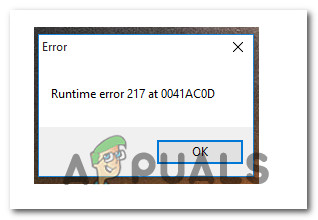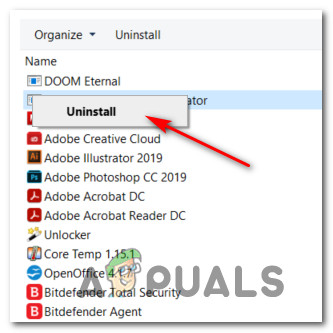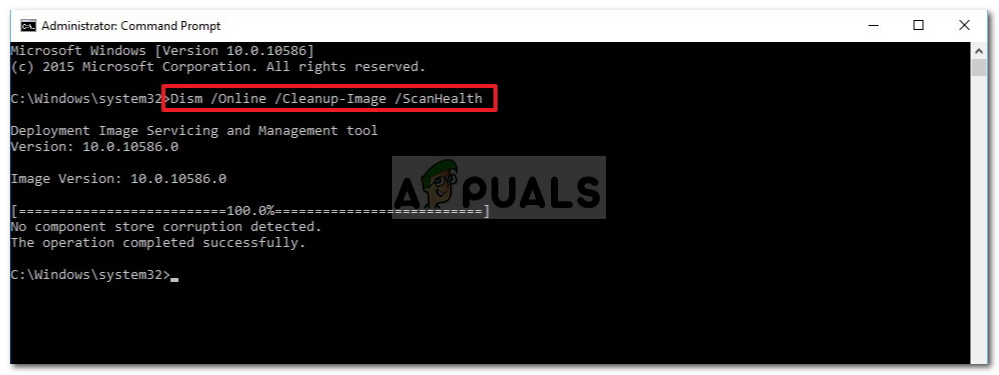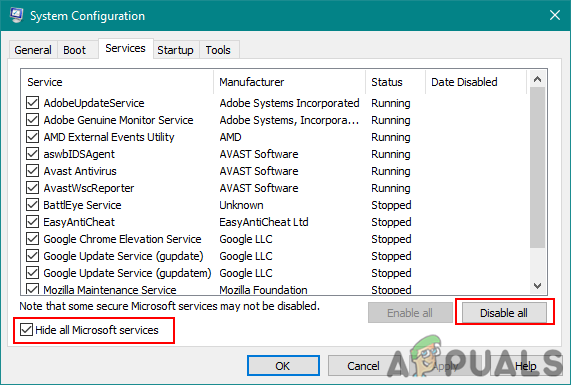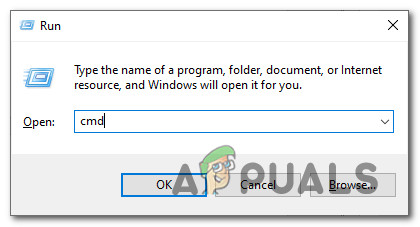After investigating this particular issue, it turns out that there are several different underlying causes that might trigger this error code. Here’s a list of potential culprits that might be responsible for this error code: Now that you know every major culprit that might be responsible for this issue, here’s a list of verified methods that other affected users have successfully used to get to the bottom of this issue:
Method 1: Reinstalling the application
Since the most common cause of this issue is an incomplete app installation, you should start this troubleshooting guide by uninstalling the app that is triggering the Runtime Error 217 (0041ACoD) and clean installing it again. This method will be effective in those instances where the initial installation was interrupted by an unexpected system shutdown, a botched update or it was blocked by your AV suite. If you haven’t tried reinstalling the application yet, follow the instructions below to do so: If the same Runtime Error 217 (0041ACoD) issue is still occurring, move down to the next method below.
Method 2: Running SFC and DISM scans
According to some affected users, the Runtime Error 217 (0041ACoD) can also appear due to some type of system file corruption that is affecting the current Windows installation. This is much more likely if you’re experiencing other similar runtime errors with multiple installed programs. If this scenario looks like it could be applicable, you should start by running a couple of scans with two built-in utilities – System File Checker (SFC) and Deployment Image Servicing and Management(DISM). These two tools share some similarities, but we recommend running both scans in quick succession in order to improve your chance of fixing the corrupted system files. Start with a simple SFC scan. This is an entirely local tool that will not require you to have a reliable internet connection. Important: After you initiate this procedure, it’s very important to not close the CMD window even if the utility looks like it froze. Wait patiently until the process is complete, as interrupting the operation might cause logical errors on your HDD or SSD. After the SFC scan is finally complete, restart your computer and see if the issue is fixed once the next computer startup is complete. If the same Runtime Error 217 problem is still occurring, deploy a DISM scan and follow the on-screen prompts to complete the operation. Note: As opposed to SFC, DISM uses a sub-component of Windows Update to download healthy equivalents to replace corrupted system files. Due to this, you need to make sure that you have reliable Internet before initiating this operation. Once the DISM scan has been completed successfully, restart your computer and check if the runtime error is now fixed. In case the same issue is still occurring, move down to the next potential fix below..
Method 3: Doing a Clean Boot
If the two methods above didn’t work in your case, you should proceed by investigating whether a 3rd party conflict that might cause the Runtime Error 217. Looking at the various user reports about this issue, it’s clear that there is a number of 3rd party programs that might create this behavior on Windows 10. There are a lot of different applications that might cause this type of behavior so the best course of action is to attempt to identify the culprit by starting your computer into clean boot mode and seeing if the issue still persists. Note: A clean boot operation will essentially put your computer into a boot state that will disallow the startup of any 3rd party service and process. If the runtime error stops occurring while you’re in clean boot mode, you can go ahead and systematically re-enable every process and startup item until you manage to identify the culprit that is interfering with the application that you’re trying to launch. If booting into clean boot didn’t fix the issue in your case, move down to the next potential fix below.
Method 4: Re-registering ChilkatCrypt2.dll (if applicable)
If you’re encountering the Runtime Error 217 while trying to launch Autodata, the issue is most likely occurring due to an unregistered registry file (ChilkatCrypt2.dll). This is very frequent with older builds of Autodata. If this scenario is applicable, you should be able to fix this issue by re-registering the problematic .dll file from an elevated Command Prompt before restarting your computer and launching the application again. A lot of affected users have confirmed that this method finally allowed them to launch Autodata without receiving the same 217 runtime error. In case you are encountering the same kind of issue with Autodata, follow the instructions below to open an elevated Command Prompt and re-register the ChilkatCrypt2.dll file: In case the same kind of issue is still occurring, move down to the next potential fix below.
Method 5: Refreshing every Windows Component
In case none of the methods allowed you to resolve the runtime error when you launch certain programs, there’s a big chance you’re dealing with some type of system file corruption that cannot be resolved conventionally. If this scenario is applicable, you should reset every relevant Windows component and eliminate every potentially corrupted OS element. When it comes to doing this, you have two ways forward:
Clean Install – TIf you’re looking for a quick fix that can be deployed without the need to use compatible Windows installation media, you can initiate a clean install procedure directly from the GUI menu of your Windows installation. But keep in mind that unless you back up your data in advance, you will lose any personal data that’s currently stored on the OS drive.Repair Install – If you have important information on the partition where you installed your Windows files, a repair install should be the way to go for you, even if the procedure is a bit tedious. But keep in mind that you’ll need to use compatible installation media. However, the main advantage is that you will be able to keep your personal files, installed applications, games, and even some user preferences rooted on the OS drive.
How to Fix Runtime Error 217 Windows 11?How to Fix Runtime Error 429 on Windows 10 and Earlier VersionsHow to Fix ‘AppModel Runtime Error 0x490’ on Windows 10How to Fix Windows Defender Runtime Error Code 1297?
